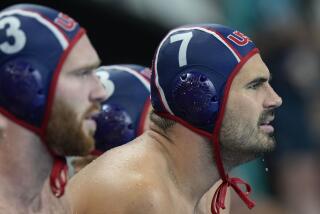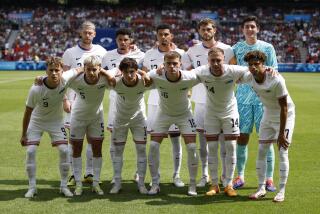Countdown to Lillehamer / ’94 Winter Olympics : No Miracle Necessary for U.S. to Win Gold : HOCKEY PREVIEW
- Share via
LILLEHAMMER, Norway — Win one gold medal, and they expect you to win one in every Olympics.
But miracles have been in short supply for the U.S. hockey team since 1980, when Herb Brooks’ squad stunned the heavily favored Soviet Union and won at Lake Placid, N.Y.
Since then, seventh-place finishes at Sarajevo in 1984 and at Calgary in ‘88, followed by a fourth-place showing at Albertville two years ago, have made mythological heroes of the ’80 team and villains of the coaches who failed to duplicate Brooks’ success.
How did Lou Vairo compile only a 2-2-2 record with a team that included Al Iafrate, Chris Chelios and Pat LaFontaine? How did Dave Peterson, who had Mike Richter, Chris Terreri, Tony Granato, Brian Leetch and Craig Janney, not win a medal at Calgary? Why, with Ray LeBlanc performing acrobatics in goal, did Peterson’s team again come home empty-handed in 1992?
Each time there was an excuse: Too tough an act to follow in ’84. Too soft a pre-Olympic schedule in ’88. Too little luck, too many defensive lapses and too much ignorance on the part of the media and fans in ‘92, according to Peterson, who played the role of Ugly American in two successive Games.
Tim Taylor offers no prefabricated excuses for the team he will coach in the Winter Games, starting Saturday. And Taylor, who coached at Yale for 17 years and was an assistant to Vairo in ‘84, might not need any.
The competition appears closer than ever, the result of the United States producing more players who have more skills, and of traditional powers Russia, Sweden and Finland losing many of their best players to the NHL. In addition, Czechoslovakia, the bronze medalist in ‘92, has split into the Czech Republic and Slovakia, diluting each.
That gives the U.S. team solid medal hopes in probably the last Olympic hockey tournament involving anything close to amateur players. In 1998, the American and Canadian teams probably will be composed mostly of NHL players.
“ Homogenized is a pretty good word,” Taylor said of the Lillehammer field. “There are nine teams that will contend for medals, and five or six that will contend for gold. You used to look at the field and say there were two or three teams that would be battling it out for the gold, and everybody else would be going for silver and bronze. I don’t think you can say that right now.”
Said Russian Coach Viktor Tikhonov, who coached the Unified Team to the gold medal at Albertville: “This Olympics will be more difficult than the previous one. Sweden, Canada and the United States have very strong teams.”
Taylor listed the gold-medal contenders as the United States, Canada, Sweden, Russia, the Czech Republic and Finland. Russia is seeded first and grouped with the Czech Republic (seeded third), Germany, Finland, Austria and Norway. Sweden, seeded second, is grouped with Canada (fourth), the United States (sixth), Italy, France and Slovakia.
Each team will play the others in its group once. The top four from each group will advance to the quarterfinals, matching the first-place team in each group against the runner-up of the opposite group.
“Obviously, our ultimate goal is to win the gold medal, and I don’t think there’s any reason we shouldn’t have that as an ultimate goal,” Taylor said. “Our expectations are high. We’re optimistic, positive and determined, but we’re realistic. It’s a very tough competition, and you have to be prepared, conditioned and focused as a team and the puck has to bounce your way.”
Taylor scheduled enough international and NHL games to gauge his team’s weaknesses, and enough games against college and minor-league opponents to build his players’ confidence. He sculpted a young, fast team, oriented toward offense, reasoning that you can’t teach a player to score but you can teach him to defend.
Team USA is 37-17-6 with one game left in pre-Olympic play after its disappointing 1-1-1 showing in the final warm-up tournament at Rouen, France, where it defeated Norway, tied France and lost to Sweden. It had a 29-13-3 record against international opponents, and scored an average of more than five goals a game while giving up nearly four. How well the Americans learned to play in their own end of the ice might be the difference between a medal and disappointment.
“They’ve been harping on defense all along,” said Todd Martin, a 6-foot-4, 210-pound defenseman who was drafted 66th by the Toronto Maple Leafs in 1989. “The forwards and defensemen are helping each other and supporting each other. The emphasis is more on defense, and it’s helped us so far.”
Unexpectedly, goaltending has become an issue. Mike Dunham, the third goalie at Albertville, was virtually assured of starting this time--until he faltered in the last two months of pre-Olympic play. Garth Snow, his teammate and roommate at the University of Maine, overtook him in goals-against average (3.19 to Dunham’s 3.89) and save percentage, .889 to .868.
“If alternating works, we will alternate,” Taylor said, but historically, that hasn’t worked.
In past U.S. successes, one goalie got all or most of the playing time: Jack McCartan led the U.S. team to the gold at Squaw Valley in 1960; Mike Curran helped win silver in 1972 and Jim Craig played every minute at Lake Placid in 1980.
The U.S. scoring threat depends on the line of Craig Johnson, Todd Marchant (the top pre-Olympic scorer) and Peter Ferraro. Marchant, who was drafted by the New York Rangers while at Clarkson University, is probably the team’s swiftest skater and used that speed to score a team-high 28 goals in 55 games before the Rouen competition. Taylor described Ferraro as “puck lucky around the net,” besides owning a hard, accurate shot.
Right wing Jim Campbell (24 goals before Rouen) and center Brian Rolston, who has adjusted well to the fast international game, are also scoring threats.
To guard the Soviet legacy of seven gold medals in eight Games, Tikhonov appears to have chosen experience over promise. He passed over 6-5 wing Viktor Kozlov of Moscow Dynamo, the sixth pick in last June’s NHL draft; Sergei Gonchar, a 19-year-old defenseman with Moscow Dynamo who was drafted 14th two years ago, and several junior stars in forming his roster. The defense, however, is still relatively inexperienced, with five players 24 or younger.
Past Soviet teams built their fluid passing game on continuity, but Tikhonov will have no players returning from ‘92, unless forwards Andrei Khomutov and Viacheslav Bykov are released by Fribourg of the Swiss League. All eight defensemen from Albertville and nine of the forwards are in the NHL, but replacements have materialized with little apparent drop-off in skill.
Sweden, which finished out of the medals at Albertville, has a mixed roster that includes five 30-year-olds, including former NHL stars Hakan Loob (Calgary Flames) and Mats Naslund (Montreal Canadiens), and a core of talented youngsters.
Defenseman Kenny Jonsson, 19, was the Swedish Elite League’s 1992 rookie of the year and was drafted 12th last June, by Toronto. A sturdy 6-3 and 189 pounds, he’s aggressive and an outstanding skater.
Also worth watching is center Peter Forsberg, traded by the Philadelphia Flyers to the Quebec Nordiques in the Eric Lindros deal. An exceptional playmaker, Forsberg was the Elite League’s most valuable player last season and was called the best young player in the world by Wayne Gretzky.
Czech Coach Ivan Hlinka vowed to make sweeping changes after a poor performance in the Izvestia tournament, a dress rehearsal for the Olympics held last December. Most of his players were in other European professional leagues and haven’t practiced much together. He won’t have to worry about goaltending, because it’s in the gloved hands of Petr Briza. Briza, 29, led Czechoslovakia to three bronze medals in the World Championships and to Olympic bronze at Albertville.
Canada had only one productive line--Chris Kontos, Vancouver Canuck holdout Petr Nedved and Mighty Duck draft choice Paul Kariya--until Coach Tom Renney made a flurry of last-minute changes to fortify the offense. He added minor-league right wing Jean-Yves Roy and Detroit Red Wing center Greg Johnson and summoned center Greg Parks back from Sweden. Also brought in were Washington Capital defensemen Brad Schlegel, a member of the 1992 silver medal-winning Canadian team, and Mark Astley, who was playing in Switzerland.
Renney’s team is strong in goal with Corey Hirsch, a draftee of the New York Rangers, and solid if unspectacular on defense. “As long as we’re sound defensively, the offense will take care of itself,” Renney said.
Several of Finland’s players will be familiar to NHL observers. Goalie Jarmo Myllys played for the Minnesota North Stars and the San Jose Sharks; Raimo Helminen was with the Rangers; Hannu Virta spent five seasons with the Buffalo Sabres and Mikko Makela skated for the New York Islanders and the Kings.
A new face is center Saku Koivu, drafted 21st last June by the Canadiens.
An explosive skater with quick moves, he’s only 5-9 and 165 pounds and might be more effective in the lighter-hitting international game than in the NHL.
Slovakia gained the final Olympic berth with the help of former NHL stars Peter and Anton Stastny. The new country won a pre-Olympic tournament, here, but it probably doesn’t have enough depth to challenge the top-tier teams.
More to Read
Go beyond the scoreboard
Get the latest on L.A.'s teams in the daily Sports Report newsletter.
You may occasionally receive promotional content from the Los Angeles Times.







